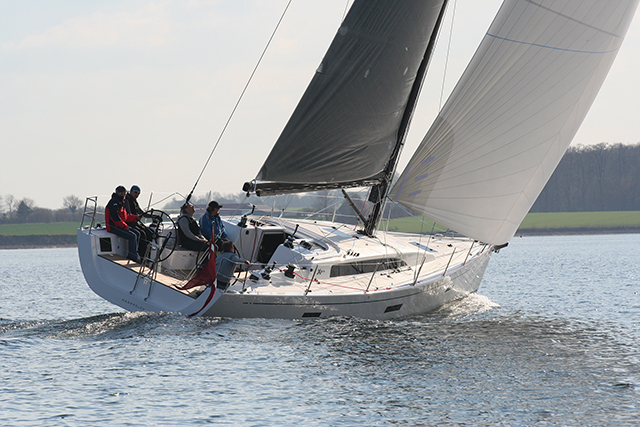BWS travels to Denmark to meet with sailing industry leaders (published February 2014)
The September morning I landed at the Billund airport in the west of Denmark was clear and warm and the breeze was blowing the tops of the trees, which augured well for the afternoon of sailing we had planned. I was met there by Lars Ostergaard, director of sales for Gori propellers, who drove us a couple of hours to meet up with Hans Vigaard, CEO of X-Yachts, Denmark’s premier sailboat builder. Despite no sleep on the flight from Boston to Billund, I was game to get out on the water and have a look at this lovely country.
Lars and I had cooked up this plan to visit Denmark and meet the leaders of its marine industry over beers at a boat show some time ago and he set out to make it happen. This junket was designed to be a fact-finding tour.
When you think of Denmark, you might think of Hamlet suffering the slings and arrows of outrageous fortune. Or you might think of the Maersk shipping lines since its containers and ships are omnipresent around the world. Or, you might think of Lego which has its world headquarters not far from the Billund airport, which local lore says was built for the convenience of the company’s thousands of international customers.
But when you think of Denmark in sailing terms, the name that rises first and foremost is Paul Elvstrøm. In the years following World War II, Elvstrøm won the Olympic gold medal in the singledhanded or dinghy class four successive times. As Europe was stitching itself back together, Elvstrøm gave the Danes a sailing hero who became one of the most prominent figures of his generation.
To give you an idea of what kind of sailor Elvstrøm was, think of him in his fifties and sixties competing in the Olymipcs and world championsips in Tornado class catamarans with his daughter Inge as crew. Beyond the Olympics, Elvstrøm won world championships in many of the major one design classes, as well.
A sailmaker and seasoned innovator, Elvstrom founded the sail loft that bears his name and created dozens of new products including the boom vang or kicking strap and hiking foot straps in dinghies. Based in the west of Denmark, he became the center of a sailing industry that grew up around him and benefited from the legend’s worldwide fame.
Although small in size and population, Denmark is a nation of sailors. A modern, prosperous, egalitarian social democracy, the Danes have arranged their lives to have enough free time that owning a sailboat and spending a lot of time with family and friends is possible for most people. Also, the country is a long peninsula, surrounded by water, endowed with fjords, island cruising grounds and the adjacent Baltic Sea, so it is a great cruising area with lots of protected water for small boat racing. Sailing is in their blood. And their sailing industry is a world leader in many categories.
Over the course of four days in Denmark, my mission was to meet with the industry leaders and come to understand just how far the Danish sailing industry has come and how it serves the worldwide sailing market, including the U.S.
SAILING THE XP-44
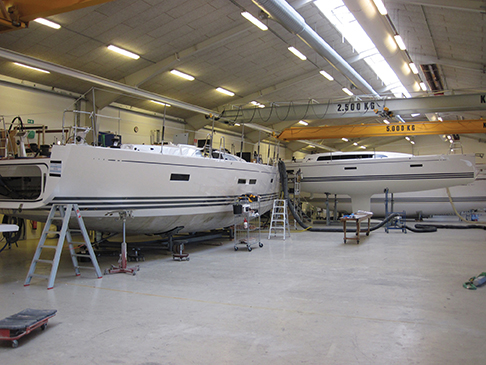
Lars and I met up with Hans and his crew and set off from the marina to have an afternoon sailing the hot racer-cruiser that typifies the performance or XP side of the X-Yachts line. As the treetops had indicated, there was plenty of breeze for a fine sail so we tied one reef in the mainsail. The design has a small 100 percent headsail so with a conservative spread of canvas we charged out into open water and gave the boat a whirl. Despite the chop, the XP 44 sailed very close to the wind and had real legs, turning out 8 plus knots at 40 degrees to the true wind. You can read the full review of the XP 44 in the December 2013 issue of BWS.
After putting the boat through her paces, we fell off the wind and reached at good speed into the fjord that was cut into the mainland and toward the town and marina where we would leave the boat. The green and lush landscape on both sides of the fjord had lovely open fields and well-tended forests ran down to the water’s edge, with very few homes visible from the water. The Danes have a different view than we do of riparian rights and tend to protect and preserve the land along the coastlines.
After a short drive from the marina to collect our car, Lars and I headed to my hotel in the town of Aabenraa for a well-earned beer and dinner before I sank into bed, having been awake for very nearly 48 hours.
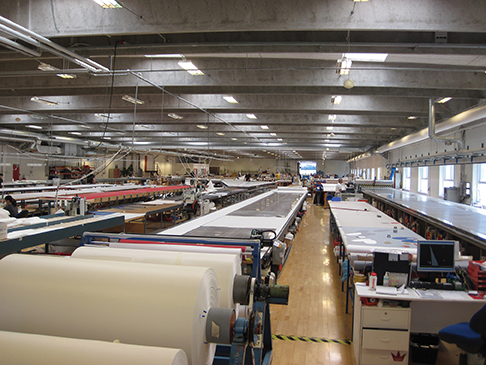
SAILMAKER TO THE WORLD
Bright and early the next morning, Espen Kamperhaug, director of sales for Elvstrøm Sails in Aabenraa, picked me up from the hotel and drove us to world headquarters for a tour. Elvstrøm is not represented by a loft in the U.S. at this point, but it has lofts all over the world and plays a dominant role in Europe as the sailmaker for boat builders such as Bavaria, Hanse, the Beneteau Group and many more.
Paul Elvstrøm founded the loft in 1954, initially working in his parents’ basement. His dinghy sails quickly gained a reputation as the fastest sails in the fleets he raced in and on that basis the loft began to grow. Today, Elvstrøm Sails delivers sails all over the world from the one huge loft in Denmark.
The product lines run the full spectrum from simple, durable cross cut Dacron sails to radial cut Dyneema to double taffeta, carbon fiber laminated sails to the most exotic film on film laminated Mylar with Aramid fiber yarns.
The loft is laid out with enormous tables so the sail makers do not have to spend their days on their knees or sitting down in recessed sewing stations. The shop where the laminated or Epex sails are built has a giant vacuum table with the string-laying gantries and heat lamps suspended over it. This workspace looks like a “clean room” where satellites are built and has a highly efficient air filtering system to keep dust from getting into the laminates as the sails are built.
Unlike the largest sailmaking companies in the world, Elvstrøm has chosen to build all of their products in Denmark instead of setting up lofts in developing nations with low labor rates. The result is sails of consistently high quality that are built one at a time to meet each customer’s specific needs.
Espen Kamperhaug, a transplanted Norwegian, has seen the company grow steadily in the past decade and as the recession ends in Europe, he anticipates continued growth in the years ahead. The company, he says, will thrive by maintaining the highest standards, providing the best service and delivering sails that fit and are very fast.
RIGGING EXPERTS
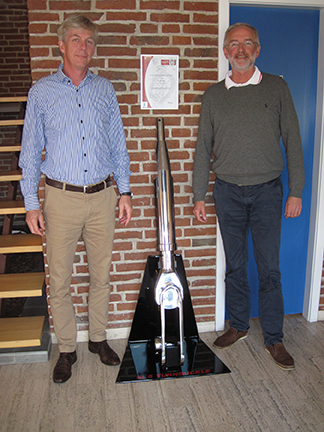
After lunch in the company cafeteria, Espen drove me to Haderslev and to the BSI factory. If you ever wondered where the huge turnbuckles on super yachts and maxi racing boats or even the normal turnbuckles and tangs on Selden Spars come from, then you will want to know about BSI. I was met by BSI’s principal Eric Quorning who spent the afternoon walking me through their huge plant.
BSI has been building super yacht rigging and fittings, rod rigging and hardware for 30 years. Along the way they have established the company as the leader in all types of high end rigging from standard stainless steel to the most exotic carbon fiber stays and shrouds.
BSI uses sophisticated cutting and machining tools to fabricate these exotic stainless steel parts. As the supplier of 85 percent of the rod rigging used in Europe, they have specialized in creating lightweight but extremely strong mast end fittings that require enormously powerful pressing machines.
With the advent of synthetic rigging in modern race boats, the company has partnered with leading experts in the field to deliver high tech PBO and Kevlar rigging components to spar manufacturers.
A leader in the super yacht field, BSI has become the rigger and re-rigger of choice. In Europe, yachts in charter have to have their rigs professionally inspected every five years and BSI specializes in this task. So if you are chartering a 120-foot Jongert, you can be assured that the mast is going to stand up because the rigging has been regularly inspected and sections have been replaced at specified intervals.
BSI also manufactures handsome hatches and portlights under the brand Moonlight, which are used on a number of production boats throughout Europe. And, they manufacture high end deck hardware, including rope clutches, blocks and mainsheet systems known as the Easy brand.
BSI and Eric Quorning have been mainstays, so to speak, of the Danish sailing industry and the European sailing market for a generation and continue to innovate and engineer the highest quality rigging, rigging components, hatches and deck gear.
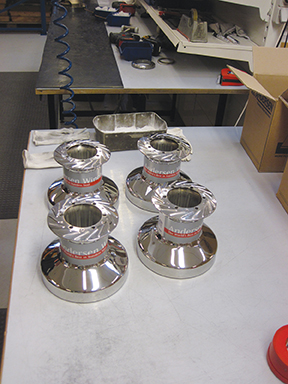
HARDWARE LEADERS
After a pleasant dinner with Eric and Larks and a night at the Hotel Koldingfjord, I was met the following morning by Thomas Meyer who is the managing director of Ronstan Europe and Andersen Winches. From there we drove to the plant in Vejle where Ronstan and Andersen are based. Ronstan purchased Andersen winches a couple of years ago and recently amalgamated the two independent plants into one. In the process, Meyer and his associates were able to completely rethink and retool the manufacturing for both the marine hardware and winch businesses.
After coffee and strudel in the boardroom, Meyer gave me a tour of the facility. Ronstan is an Australian company that has grown to be one of the top marine gear and equipment companies in the world. It was founded in 1953 and grew into a large international company with divisions in the U.S. and Europe.
In 2001, Ronstan bought Frederiksen, the leading Danish marine hardware company, which was the premier manufacturer of high end blocks and deck hardware for large racing boats. The move gave Ronstan a great product line all across the sailing spectrum and it gave them a new foothold in Europe from which Meyer can run the European operation.
As we walked through the newly reorganized plant, it looked a model of LEAN manufacturing. Machine tools were cutting the essential parts for blocks and shackles in a logical step-by-step process. It was interesting to see that one skilled machine tool operator could manage several operations at once so the shop floor was not busy with lots of employees.
Watching winches go together was a first for me. Andersen winches have stainless steel drums that have vertical ribs to provide grip on the line that is around it, but are slippery enough to allow the line to be eased without chafe. The drums themselves are formed in a huge press while the winches’ internal parts are machined to incredibly precise tolerances.
The assembly of the Ronstan and Andersen final products takes place on a production line at the back of the manufacturing plant and right next to the shipping docks. Again, it was interesting to see how modern assembly techniques and planning can increase the efficiency of the specialists who put all the hardware together.
After a comprehensive tour of the plant, we walked across the alley to the testing shop so we could do side-by-side tests of an Andersen winch versus one of its competitors. The test line was half-inch double braid with a large weight at its far end. We put two turns around the no name winch, and began to crank the handle. The winch turned but it could not grip the line so it just spun aimlessly. On the Andersen winch, we tried the same test and found that the ridges made a huge difference in the gripping power of the drum.
In Denmark, the synergies between Ronstan, the old Frederiksen and Andersen have created a worldwide marine hardware company that delivers beautifully made products for boats from Optimist prams to super yachts.
BOATS THAT FLY

 After a pleasant lunch, Thomas kindly drove me to Frederica where I was met by Jorn Ravensbjerd at the Dragonfly plant. Quorning Boats builds the Dragonfly range of high performance cruising trimarans from 28 to 37 feet in a plant they have occupied for 45 years.
After a pleasant lunch, Thomas kindly drove me to Frederica where I was met by Jorn Ravensbjerd at the Dragonfly plant. Quorning Boats builds the Dragonfly range of high performance cruising trimarans from 28 to 37 feet in a plant they have occupied for 45 years.
Founded by Borge Quorning in 1967, the company is now run by his son Jens. If you think the last name sounds familiar, it should; Jens’ brother is Eric Quorning who owns and runs BSI. Since the early days, Quorning Boats has designed and built more than 1,250 boats, and since 1981 they have focused exclusively on their Dragonfly line of tris.
Dragonfy tris are all designed and built with what they call “swing wings” or folding amas. The outside hulls have hinges at the main hull end of the cross beams so the hulls can fold back against the sides of the main hull, thereby reducing the tri’s beam dramatically; this allows you to fit a 32 foot tri with a 25 foot beam into a normal monohull’s marina berth. Redeploying the amas takes five minutes or less and can be done from the cockpit. It is a clever solution to a broad beam problem.
The beauty of the Dragonfly line of boats lies in their superb sailing qualities coupled with roomy and comfortable interiors. The boats are built with centerboards so they can have very shoal draft for thin water cruising and beaching the boat. But, with board down, the boats have excellent windward sailing capabilities. The whole Dragonfly concept is fast cruising, and in the right breeze a Dragonfly can sail at 20 knots.
The board fits in a centerboard trunk that runs down the middle of the cabin and thus becomes the support for the saloon table. The boats’ interiors are simple but elegant and have good spaces to sit, comfortable bunks, enclosed heads and simple galleys.
Jorn and I drove down to the local marina to look at the new Dragonfly 32, the latest design in the line. The boat has six berths that are six and a half feet long. The folding dining table will seat six easily and the galley is large enough to prepare meals for this crowd.
The Quornings are engineers who like to innovate so the sailing systems, rig and running backstays are all designed for a couple to handle the boat easily and to sail fast. Unfortunately, we could not get out for a sail because I am sure, in the good breeze that afternoon, we would have seen the 32 nearly fly.
Dragonflys are sold all over the world and you will find a few in North America. And, if you have seen one while you are out sailing, it was probably blowing right by you.
X MARKS THE SPOT

The next morning, I was met at my hotel by Flemming Ancher, the director of Sales for X-Yachts in Haderslev. When we arrived at the boatyard, Hans Vigaard was there to meet us and then Flemming gave me a tour of the boat building facility. We finished up with a good long look at the new boats, which they have on display in an indoor showroom.
X-Yachts was founded in 1979 by brothers Jens and Lars Jeppesen and their friend and partner Birger Hansen. As Birger told me, a name for the company eluded the three partners at inception so they called it “X” as a placeholder and the name stuck. Their first designs were immediately successful on the racecourse. Over the years, their boats have won nine ORC World Championships, the Admiral’s Cup and the Commodore’s Cup, all top European regattas.
Today the company builds 13 different models from 33 to 65 feet divided into three categories: XCruising, XPerformance and XRacing. The XP 44 I sailed with Hans is right in the middle of the performance range and is a very good example of the kinds of boats that have made X-Yachts one of the most successful builders of high end sailboats in Europe. The XRacing line focuses on their two one-design classes that are popular throughout Europe, the X-35 and X-41.
The XCruising line is new in the recent history of the company. The cruising boats are very finely finished, moderate displacement cruisers that compete very favorably with other Northern European brands such as Hallberg-Rassy. If you are looking for a performance cruiser with all of the amenities and comforts of a true luxury yacht, then the XCruising boats should be on your short list. The boats are beautiful and built with integrity.
The hulls and decks are cored and infused under pressure. The hull is reinforced with a steel girder and frame that bears the strains of the keel, chain plates and mast step. All through hull fittings are recessed to reduce drag and the bulbed, fin keels and spade rudders are high aspect, NACA foils. Even though these are performance boats, whether racing or cruising, you can have most of the designs with teak decks.
Flemming and I spent a lot of time aboard the XC 45 going through its systems and getting to know how the boat was built. He explained that all of the X Yachts are built to last a lifetime while offering excellent sailing performance. The 45 had a three cabin two head layout that would be perfect for a couple, a family of four, or two or three couples cruising together.
Not long ago, the three partners sold the company to the Danish investor Ib Kunoe who was also an X-Yachts owner. Neils Jeppesen, who lives in England, remains the chief designer and “genius” of the organization; Lars remains with the company as the chief of technical performance and delivery of the yachts; and, Birger remains as a customer service manager.
PROPER PROPELLER

After a very pleasant morning at X-Yachts, Birger drove me to the Gori factory, which was not far away. Lars met me there and I spent an interesting afternoon learning how the elegant but surprisingly complex Gori folding propellers are made.
Gori is a division of a larger company called Steel Team, which is very involved in the commercial wind generator business; Denmark is a world leader in the design and manufacture of wind turbines and Steel Team has specialized in machining parts as a sub contractor for the large turbine companies.
The Gori propeller business makes use of all of the company’s expertise in the design and machining of precision products. Gori props are folding propellers with asymmetrical hydrodynamic blades that fold together when the shaft is not turning and deploy due to centrifugal force when the engine turns the shaft. This is essentially how all folding propellers work.
The Gori difference lies in the way the blades deploy in forward and reverse. In the three and four blade props, the blades actually articulate through 180 degrees so the pitch remains the same whether going forward or backward. But, because of the shape of the blade, the trailing edge exposes a much steeper pitch to the water than does the leading edge; therefore, if you put the propeller in reverse and then shift the transmission directly into forward, the prop will remain in the reverse position and will expose the steeper pitch to the water, providing a lot more torque or power.
The net result of this “overdrive” configuration is more drive at lower engine revs and thus more engine efficiency and lower fuel consumption. At normal cruising revs, the difference in fuel consumption works out to be about 30 percent. One caution, however, needs to be mentioned: with the much steeper pitch and greater torque in overdrive, you should not run the boat into a steep chop or head sea since each collision with a wave will add resistance to the prop and could damage the transmission or engine mounts. Overdrive works best in mild conditions and flat seas.
Gori makes four different folding propellers: a two bladed cruising prop, a two-bladed racing prop, and three and four bladed folding props. The racing prop has a slightly different and flatter shape so the blades will fold closely together and thus reduce drag to an absolute minimum. The hubs for the propellers are machined on site in very modern and sophisticated machines. The blades, which incorporate the gears, are cast off site and then finely machined at the factory.
As you can imagine, the blades of each prop have to be matched; they need to be the same weight and have the same balance, otherwise the prop will spin slightly off center and will vibrate. So, before shipping, every prop is run through a testing tank and given the final adjustments.
The Gori facility and processes are state-of-the art manufacturing, which is highly automated andrequires only a few skilled machinists and assembly workers to turn out the finished products. And, the finished propellers reflect this modern approach since they are so precisely finished, balanced and almost look like works of sculptural art.
Replacing a three-blade fixed prop on any auxiliary powered sailboat with a folding prop will add up to a knot of speed under sail; the Gori difference lies first in the very high quality of the finished products and, second, in the unique overdrive function.
DENMARK
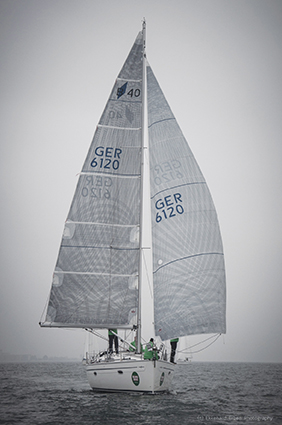
My fact-finding tour of the Danish marine industry was a whirlwind and early the next morning, after a pleasant send off dinner with Lars, I was on a flight headed back across the Atlantic. Yet, a lot of what I saw and learned in Denmark stays with me.
The hospitality of my hosts was warm and generous. Competent, articulate and thoughtful professionals smartly ran the businesses I visited, everyone spoke English and I spoke not a word of Danish. The sailing industry in Denmark and Europe has been in a downturn due to the recession in much the same way it has been in the U.S., yet the companies I visited have survived and learned to thrive in a smaller market; and, the contributions this small sailing nation have made to the world of sailing are many and important. The traditions that started with Paul Elvstrøm are carried on by the next generation and improved upon at every turn, which has proven to be a very winning combination.
















